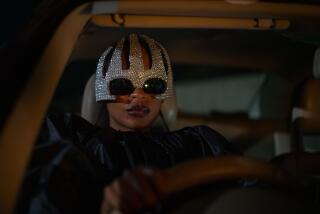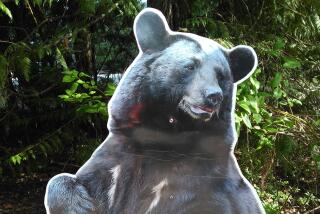Mother’s Nature : THE FEMALE ANIMAL <i> by Irene Elia; introduction by Ashley Montagu (A Donald Hutter Book / Henry Holt: $21.95; 318 pp.</i> ; <i> 0-8050-0702-4)</i>
- Share via
It is still widely rumored among members of our species that women are designed for domestication and that there is salvation, fulfillment and protection for women in marriage. If God (or nature) had not intended women to be caretakers of children and keepers of the home, then why did God (or nature) make women ovulate, gestate, lactate and so well-attuned to the feelings of others?
“The Female Animal” is a protest in the name of polyandrous quails, hermaphroditic anglers and parthenogenic lizards against any scheme, divine or natural, to tame the human female. It is written by Irene Elia, a biological anthropologist, a Darwinian, a modern liberated woman and, as she tells us, a nursing mother who feels oppressed and endangered by the status of females in human society, by the disproportionate burden of parenting endured by the weaker sex of our species, and by the institution of marriage.
Marriage, fidelity, chastity and several other contemporary indecencies are linked in the modernized consciousness of Elia to male coercive power, which she views as a menace to the well-being and even survival of women.
The book concludes with an ominous forecast about the evolutionary consequences of future technologies for artificial reproduction and human cloning: “Why would the Nobel Prize-winning sex let the sex with the boring, meaningless lives eat up half the food if they are no longer needed for reproductive reasons?”
In “The Female Animal,” Elia is out to rectify the status of women and to show how across all life forms--from bacteria to mammals--there is more to the life of females than producing eggs, attracting mates, making babies, tending the brood and being passed over for jobs or promotions.
Elia seeks to upset our conceptions about sex roles with a series of vivid, witty and provocative descriptions of alternative experiments in living among algae, bacteria, birds, fish, reptiles and mammals, with special reference to reproduction, parenting responsibilities and gender differences in looks, attitudes and behavior.
In most species, it turns out, parenting is not the specialization of females, and it is not always true that males are larger than females or that the sexes are distinguished by their genitalia.
Every political culture has its origin stories. In the now popular Darwinian genre of storytelling, Mother Nature has a master goal and the storyteller sticks to a simple fixed theme.
The goal: Win in the struggle to get your genes into the next generation.
The theme: If you have a very long time to mindlessly pursue your selfish advantage, you’ll eventually come up with something inventive that makes you and your next of kin well-suited for survival and reproductive effervescence in your environment.
Elia is a Darwinian narrator spinning a graceful and scholarly tale about how parenting got associated with the female sex, about fertilization, contraception, courtship, gestation, infanticide, menstruation, breast-feeding and the evolution of sexuality and male/female differences.
The central chapters of “The Female Animal” can be read as a kind of “Gulliver’s Travels” across life forms. There is delight in the journey and you will learn things.
The book is at its best reviewing comprehensively the ingenious designs for sexual and asexual reproduction to be found in nature--especially among the more remote species, birds, fish, insects and reptiles. Truth, the reader is reminded, can be more fantastic and mind-boggling than fiction.
After which creative life form, should the modern liberated woman model herself?
How about the praying mantis, which eats her mate alive while he is totally absorbed in making love to her?
What of the Holboell angler? The female is 45 inches long while the male is but half an inch long. His destiny is to permanently jaw his way into her flank and there become physically transmuted into her testis, a sperm-producing female organ, forever more her “reproductive convenience.”
Or perhaps the ideal model for modern women are those parthenogenic lizards, the world’s experts in “virgin birth,” which do not need males or sperm at all. The entire species is female, and their eggs are self-fertilizing.
Let us not overlook the polyandrous quails, where the female has several husbands that assume the responsibility for feeding the kids.
Or the fabled queen honey bee. She takes away from her drone suitor his penis, which she breaks off and keeps for herself. He flies away to bleed to death.
It is not just coitus that can be hazardous to your health. Risky as well, I suspect, is the whole business of using non-human nature to serve human political ends. Nature is various enough to serve as a model for almost any ambition; and it has, and it will.
So for the traditionalist there is the Canada goose, monogamous and devout, which, once widowed, will never mate again.
And for macho man there is the female African clawed toad. She succumbs seductively to the sexual advances of a smaller yet more combative mate, which knocks her unconscious while he squeezes out her eggs.
Now, before we became modern and enlightened and liberated and Darwinian, it used to be a curse to be turned into a toad or a lizard and an insult to be compared to a snake or a swine, as in “you chauvinist pig.”
Living things that copulated in public, or beat up their wives, or cannibalized their husbands or children, or stayed up hotting all night, used to be ranked down a bit on the hierarchy of species.
Human beings were presumed to be relatively close to the gods.
Human practices and values, such as the differentiated yet interdependent and loving relationship between men and women, were presumed to be high, dignified and just, and they served as a standard for judging the varieties or deviations or perversities found in nature.
It was Darwin’s modernist origin story that changed all that. Given today’s ways of thinking, if you are really lyrical about it--out to maximize your selfish advantage in a narcissistic Darwinian quest for this--worldly immortality--you might want to consider becoming a bacterium and reproducing, without the need for a mate, hundreds of thousands of replicas of yourself within a few hours.
Indeed, after finishing “The Female Animal,” I was left wondering why we are not all asexual bacteria.
Asexual bacteria are among the most ancient life forms. They are still here. They are everywhere.
If your ultimate goal in life is to survive forever, why not keep it simple?
What self-regarding egoist would want to be a complex needy human being, with so few progeny?
And how cumbersome to have to cooperate with, or oppress, another sex in order to make it in life.
Darwin’s origin story is an eye-opener yet its incessant refrain, chance advantage and a lot of time, makes for dulled reasoning after a few repetitions.
I once heard an anecdote about J. B. S. Haldane, the famous British biologist. Haldane lived the last years of his life in a remote district in India, where people thought they knew something about the sanctity of humans and the hierarchy of species.
A local Hindu asked Haldane what his research on biology in India had taught him about the nature of God. Haldane replied that God must be an insect: Judging from the numbers and the varieties, it is nature’s most successful design.
Haldane might as well have said that God is a bacterium. God is not dead. He is bacterium, multiplying selfishly in your gut. Darwinian thinking must be a blessing in disguise. Let’s hope so.
“The Female Animal” is a poetic piece of sociobiology, which not only appropriates nature to feminist ends but does it in the modern Western libertarian way, with a kinky fascination for alternative life styles.
Perhaps it is not surprising that our author is far better at describing nature’s diverse designs than at explaining how they ever got there, or that nature fails to speak with a single or consistent voice about male/female issues.
Fortunately, Darwinian storytelling notwithstanding, the origins of nature’s various and astonishing species is still mysterious and a decent subject for fables.
Fortunately, rational debates about the rights, duties, sacred obligations and proper relations of men and women in human society are not likely to be settled by nocturnal gazing at the mating behavior of hairy woodpeckers.
The voyeuristic pleasures and vicarious satisfactions of looking over Mother Nature are, of course, quite another matter, and, after reading this review, my wife told me to say that “this male chauvinist pig liked the book, for the nature stuff.”
More to Read
Sign up for our Book Club newsletter
Get the latest news, events and more from the Los Angeles Times Book Club, and help us get L.A. reading and talking.
You may occasionally receive promotional content from the Los Angeles Times.









